1950s
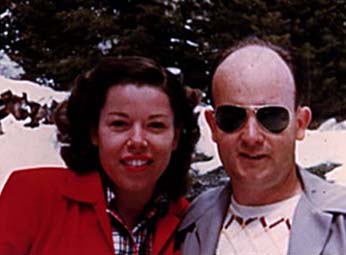 I
was born in 1952 in Lakeport, Lake Co., California, of middle class parents.
My father, B.B. Roberson, met my mother Eleanor in 1948, just after World
War II. My dad was just starting his medical practice and my mom was a
singer in Hollywood. My mom, known as "Sally," sang with her three sisters
in a group called The Lyttle Sisters. All four sisters married before 1950
(three of them married musicians) and started families. This photo (right)
is of my dad and mom in about 1950, somewhere in the snowy mountains. My
father was an avid snow skier and water skier; he loved to travel; and
he always had a fast sports car. Both had been raised Seventh-day Adventists,
and planned to raise their family in that religion (my mom's other three
sisters did not stay in the church). I
was born in 1952 in Lakeport, Lake Co., California, of middle class parents.
My father, B.B. Roberson, met my mother Eleanor in 1948, just after World
War II. My dad was just starting his medical practice and my mom was a
singer in Hollywood. My mom, known as "Sally," sang with her three sisters
in a group called The Lyttle Sisters. All four sisters married before 1950
(three of them married musicians) and started families. This photo (right)
is of my dad and mom in about 1950, somewhere in the snowy mountains. My
father was an avid snow skier and water skier; he loved to travel; and
he always had a fast sports car. Both had been raised Seventh-day Adventists,
and planned to raise their family in that religion (my mom's other three
sisters did not stay in the church). |
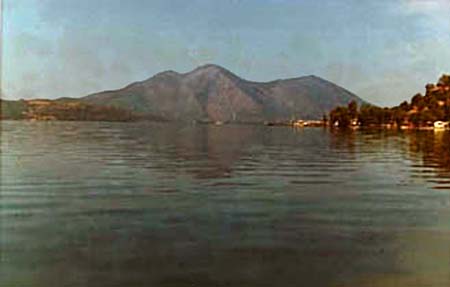 In
1950, my father took a position as the only doctor in a little town at
the south end of Clear Lake, then-known as Clearlake Highlands [today it
has been renamed Clearlake]. We moved to a home on the lakeshore when I
was 2 years old and my sister was born. The home was on 1.5 acres and had
a pier; this view (left) is from the pier and looks north at Mt.
Konocti. My home town had about 5000 people in a very rural county. I went
to a tiny, private Seventh-day Adventist school (I was raised in that religion
but I no longer practice it). I had the same teacher, Mrs. Howland, for
all 8 elementary grades in a classic "little red schoolhouse." In
1950, my father took a position as the only doctor in a little town at
the south end of Clear Lake, then-known as Clearlake Highlands [today it
has been renamed Clearlake]. We moved to a home on the lakeshore when I
was 2 years old and my sister was born. The home was on 1.5 acres and had
a pier; this view (left) is from the pier and looks north at Mt.
Konocti. My home town had about 5000 people in a very rural county. I went
to a tiny, private Seventh-day Adventist school (I was raised in that religion
but I no longer practice it). I had the same teacher, Mrs. Howland, for
all 8 elementary grades in a classic "little red schoolhouse."
We had a bird feeder right outside the window where we ate breakfast,
and I knew all the local birds by the time I was 8 years old. My dad had
a Peterson Field Guide to Western Birds, and I was a user
of it very early on. As a child I liked making model airplanes and battleships,
but also model birds of the same genre. I would paint them the correct
colors and glue them together, and sometimes place them outside in 'realistic'
settings. So I was always very comfortable with our backyard birds. |
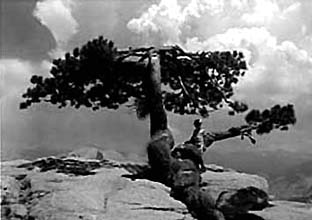 We
also went to Yosemite Nat'l Park every summer, and I knew the common birds
there also. Here's a picture my father took (right) of me at 9 years
old at the lone Jeffrey Pine on Sentinel Dome. This was a favorite and
oft photographed tree back then; it has since been struck by lightning
and killed, with only the stubs remaining. I also knew all the features
of Yosemite at any early age. The photo (below) of my sister Cheryl
and me is from about 1959. We
also went to Yosemite Nat'l Park every summer, and I knew the common birds
there also. Here's a picture my father took (right) of me at 9 years
old at the lone Jeffrey Pine on Sentinel Dome. This was a favorite and
oft photographed tree back then; it has since been struck by lightning
and killed, with only the stubs remaining. I also knew all the features
of Yosemite at any early age. The photo (below) of my sister Cheryl
and me is from about 1959.
|
|
1960s
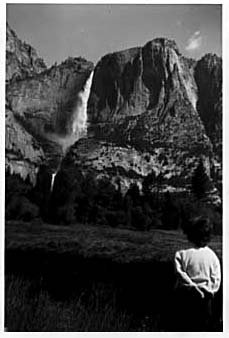 Sticking
with the Yosemite theme for a moment, here (left) is one of my first
photographs with a Kodak Brownie print camera. It shows Yosemite Falls
in 1962 with my sister in the foreground. My dad taught me about photography
and lighting and format. My dad always wanted people in the photo to provide
perspective or balance. As I grew older, I preferred photos of scenic wonders,
or of historic places, without people. Even as a kid I had the patience
to wait until the people left to take my preferred photograph. Sticking
with the Yosemite theme for a moment, here (left) is one of my first
photographs with a Kodak Brownie print camera. It shows Yosemite Falls
in 1962 with my sister in the foreground. My dad taught me about photography
and lighting and format. My dad always wanted people in the photo to provide
perspective or balance. As I grew older, I preferred photos of scenic wonders,
or of historic places, without people. Even as a kid I had the patience
to wait until the people left to take my preferred photograph.
The 1960s were my teenage years. Growing up in such a rural area, in
such a small town and going to such a tiny school, surely had a major influence
on me. I really didn't have any close friends my own age, so I very much
learned to entertain myself. I loved reading. And I really got interested
in baseball, especially the San Francisco Giants. I'd listen to Russ Hodges
and Lon Simmons on the radio, describing the exploits of Mays, McCovey,
and Marichal. I also did a lot of 'playing baseball' by myself by throwing
a tennis ball against a rocky wall and then trying to field the line drive
or ground ball or whatever came back at me. Here (below) are a couple
of prints of my boyhood backyard.
| A very rare snowfall in the backyard, seen from our pier. This photo
must be about 1963. |
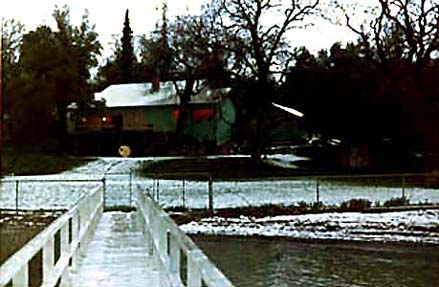
|
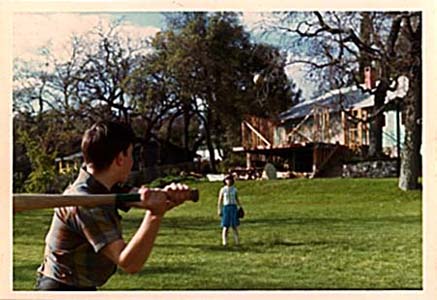
|
A little backyard baseball in about 1965. My sister is pitching to
me; a rare event. Note we are adding a new family room to the house. |
|
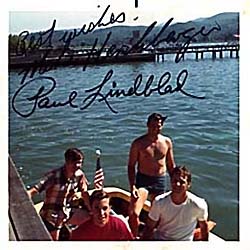 The
Giants have always remained "my" team but in 1968 the Athletics moved from
Kansas City to Oakland, and by pure luck I got to meet a couple of the
Oakland As. During the July All-Star Break, three of the As vacationed
at Clear Lake with their families, and one of their kids cut a foot and
had to have stitches. They went to my dad, the doctor in town, who sewed
up the kid and invited them out on my dad's speedboat. My dad had to work
but the neighbor boy from the summer cabin next door and I took Mike Hershberger
and Paul Lindblad out water skiing for a day (the 3rd ballplayer, Danny
Cater, had already gotten a bad case of sunburn). I'm in the plaid shirt
(right) with the two ballplayers in our boat in this autographed
snap shot. We all had a barbecue at the neighbor's summer home that evening,
and Lindblad showed me how to throw a few pitches, although he was a lefty
and I was not. The
Giants have always remained "my" team but in 1968 the Athletics moved from
Kansas City to Oakland, and by pure luck I got to meet a couple of the
Oakland As. During the July All-Star Break, three of the As vacationed
at Clear Lake with their families, and one of their kids cut a foot and
had to have stitches. They went to my dad, the doctor in town, who sewed
up the kid and invited them out on my dad's speedboat. My dad had to work
but the neighbor boy from the summer cabin next door and I took Mike Hershberger
and Paul Lindblad out water skiing for a day (the 3rd ballplayer, Danny
Cater, had already gotten a bad case of sunburn). I'm in the plaid shirt
(right) with the two ballplayers in our boat in this autographed
snap shot. We all had a barbecue at the neighbor's summer home that evening,
and Lindblad showed me how to throw a few pitches, although he was a lefty
and I was not. |
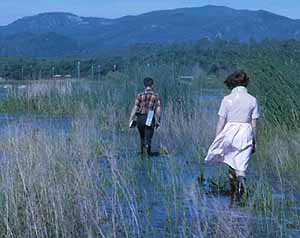 In
1965 or 1966, I read a story in Reader's Digest about the Audubon
Society's Christmas Bird Counts. Of course, my hometown was much too small
to have an Audubon Society or even any birdwatchers. But I decided to do
my own on Christmas Day. I got up a dawn, peddled my bicycle around town,
and counted birds. It was my first day of real "birding" and I still have
vivid memories of some of the species identified with my Peterson field
guide that day, including a lovely male Bufflehead
(below left; I took this photo many years later:). In May 1967,
a visiting fire-and-brimstone preacher happened to be a birdwatcher, and
arranged a walk in Anderson Marsh at the south end of Clear Lake. I was
then 15 years old, and my dad and my good friend and neighbor, Jeanne Spalding,
came along (photo left). The highlight was finding the nest
of a Virginia Rail (below right). My
dad took this photo of the eggs; I took an identical photo (and another
that shows the bird itself) with my print-film camera. Those were my first
bird photos. Later that summer my dad, sister and I visited Europe and
I saw my first "life birds" outside North America. In
1965 or 1966, I read a story in Reader's Digest about the Audubon
Society's Christmas Bird Counts. Of course, my hometown was much too small
to have an Audubon Society or even any birdwatchers. But I decided to do
my own on Christmas Day. I got up a dawn, peddled my bicycle around town,
and counted birds. It was my first day of real "birding" and I still have
vivid memories of some of the species identified with my Peterson field
guide that day, including a lovely male Bufflehead
(below left; I took this photo many years later:). In May 1967,
a visiting fire-and-brimstone preacher happened to be a birdwatcher, and
arranged a walk in Anderson Marsh at the south end of Clear Lake. I was
then 15 years old, and my dad and my good friend and neighbor, Jeanne Spalding,
came along (photo left). The highlight was finding the nest
of a Virginia Rail (below right). My
dad took this photo of the eggs; I took an identical photo (and another
that shows the bird itself) with my print-film camera. Those were my first
bird photos. Later that summer my dad, sister and I visited Europe and
I saw my first "life birds" outside North America.
|
| At the end of the decade I went to a boarding high-school in Healdsburg,
and met the first birders my own age: Wally Sumner and Ken Knittle. They
were seniors in high school while I was a freshman, so I only had one year
with other birders before they graduated. We would take a bird walk around
campus every Saturday morning before breakfast.
Rio Lindo Academy was a Seventh-day Adventist coed school of perhaps
300-400 students. Adventists are very conservative and strict in many ways:
no popular music, no T.V., no drinking, no cards, no radios, and, although
we were allowed 'dates' on certain 'date' nights at the cafeteria, no hand-holding
or kissing. I was raised vegetarian and Rio Lindo served vegetarian meals.
So my teenage years were very different than most Americans. Adventists
also tend to be very conservative in politics, and my parents were Republicans.
But Rio Lindo was a great awakening for me because of the interaction with
other students, and because of the philosophical influence of my classmate
Jim McCluskey. He taught me that it was okay to think for myself. So while
I went to Rio with very conservative ideas, but the time I graduated four
years later, I had become a liberal in politics; I was strongly against
the Vietnam War; and I was worried about the draft. I had very good grades
but was also considered somewhat of a radical leader by my senior year
when Jim McCluskey [purple dot in photo below] and I [orange-red dot below]
edited an "alternative' school newspaper called St. Elmo's Fire.
The paper was a big hit with the students but when the more conservative
faculty figured out we were lampooning them and their ideas, they forced
a recall of our current issue. So the photo below, published in my high
school yearbook, is of the student staff of St. Elmo's Fire burning
our teacher adviser, Mr. Loveless, 'at the stake' with the recalled issues
of St. Elmo's Fire.
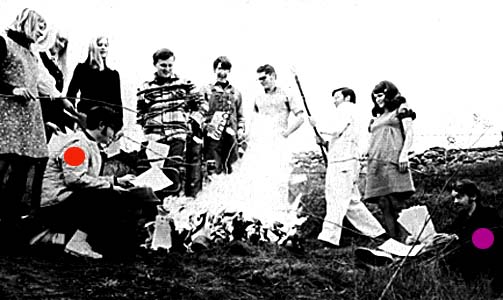
|
|
1970s
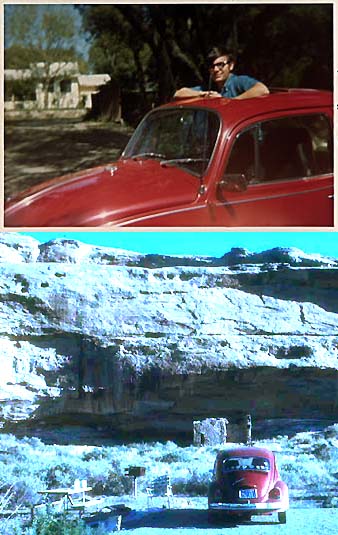 In
May 1970 I turned 18 years old. As it happened, I had a mid-level draft
number and they did not reach my number that year, so I never had to face
the Vietnam conundrum. On my 18th birthday my parents gave me my first
car, a little red VW beetle (right). As soon as school was out in
June, I spent a month traveling by myself to National Park and Monuments
throughout Arizona and New Mexico. It was very much a trip 'on the cheap,'
camping out every night and eating canned food cooked over a fire, if not
just 'straight from the can' cold. I have a photo of my campsites (right),
a cozy little spot nestled up against a tiny Indian ruin in Chaco Canyon
National Monument. In
May 1970 I turned 18 years old. As it happened, I had a mid-level draft
number and they did not reach my number that year, so I never had to face
the Vietnam conundrum. On my 18th birthday my parents gave me my first
car, a little red VW beetle (right). As soon as school was out in
June, I spent a month traveling by myself to National Park and Monuments
throughout Arizona and New Mexico. It was very much a trip 'on the cheap,'
camping out every night and eating canned food cooked over a fire, if not
just 'straight from the can' cold. I have a photo of my campsites (right),
a cozy little spot nestled up against a tiny Indian ruin in Chaco Canyon
National Monument.
The rest of the decade was mostly spent in school: graduated from Rio
Lindo Academy in 1971; went to Pacific Union College, Angwin, and then
Cal. State Hayward (B.A. in history & poly sci., 1975); and then to
law school at Hastings Law School, San Francisco (graduated 1978). I did
well in school and enjoyed many of the classes, but I did switch from a
biology major to a history major when I hit chemistry class — they wanted
way too much homework! I had better things to do. And that was to go birding.
I re-united with my high school friend, Wally Sumner, at college in
1971. That November I packed the VW with Wally, my girlfriend, and others
to drive all the way to the Salton Sea to chase Blue-footed Boobies. We
had learned dozens had appeared there. We found one of them on 6 Nov 1971:
my photo (below) shows it standing on rocks at the edge of the Salton
Sea. We also found two dead Blue-footed Boobies and brought them back to
Pacific Union College where I prepared them as study skins for the little
museum there over the next month... an odoriferous experience for all involved.
My girlfriend Jolee (we married and divorced later in this decade) and
I decided we'd had enough of religious school, and we moved to Berkeley
in 1973. We immediately fell into the birding scene there. My mentors were
great birders like Laurence C. Binford , curator of birds at Calif. Academy
of Sciences in San Francisco, and Van Remsen , then a grad-student at U.C.
Berkeley. Other regular members of the Bay Area birding crowd in those
days were Steve Bailey, Dick Erickson, John & Suzanne Luther, Joe Morlan,
Mike Parmeter, and Rich Stallcup, and later in the decade Donna Dittmann,
Jeri Langham, and many others. |

|
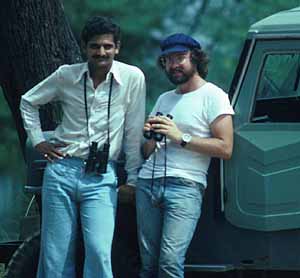 In
1975, Van Remsen put together a trip for local birders to Colombia, where
he was doing his PhD research. This was my first major foreign birding
trip — it was also the first time that I ever drank alcohol, the first
time I ever tasted coffee, and the first time I ever danced, but those
are all different stories.... In
1975, Van Remsen put together a trip for local birders to Colombia, where
he was doing his PhD research. This was my first major foreign birding
trip — it was also the first time that I ever drank alcohol, the first
time I ever tasted coffee, and the first time I ever danced, but those
are all different stories....
I also did an "around-the-world" trip with my dad and sister in 1978,
visiting (among other places) India, where I spent a day birding Bharatpur
with Raj Singh (left; that's me to the right; this is a "self-portrait"
with a timer). I got very into the California birding scene and chased
vagrants throughout the state rapaciously. In 1975 and in 1977 I attempted
serious California Big Years, and ended up second to Guy McCaskie in 1977
(with 444 birds NIB [=no introduced birds]) and wrote
a booklet about it called Birders' California, published by the
American Birding Ass'n in 1978 (it was only their 2nd book ever). The last
years of the decade were spent researching and writing Rare Birds of
the West Coast (published 1980). |
| Beginning in the late 1970s, and continuing into the early 1980s, I
did a series of SCUBA diving trips with my father, visiting the Caribbean,
the Great Barrier Reef, and the Red Sea. I learned underwater photography
with a Nikonas (below left on dive boat; me underwater — photo by
my dad. below center), and I have a wide selection of underwater
shots (below right is a Squirrelfish and wrasses).
|
|
1980s
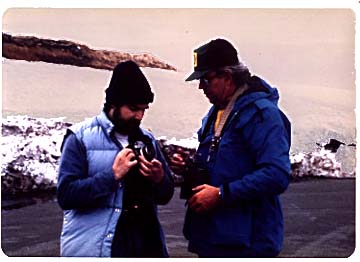 This
was the decade in which I learned Monterey County. While working on
Rare
Birds, I decided to move to Pacific Grove because it was my favorite
birding spot in California. I got an apartment just blocks from Pt. Pinos
in 1979. In May 1982 (with my dad's help) I bought the house where I still
live, at a time before Monterey Peninsula housing prices skyrocketed beyond
most everyone's means. I birded throughout the county while working at
part-time jobs, and wrote Monterey Birds (published 1985). I continued
to search for vagrant throughout California, and served as Secretary for
the California Bird Records Committee for five years. I also did an Attu
Island trip in 1980 for my ABA list; someone took this print (right)
of Guy McCaskie and me on Attu, discussing — of all things — photography. This
was the decade in which I learned Monterey County. While working on
Rare
Birds, I decided to move to Pacific Grove because it was my favorite
birding spot in California. I got an apartment just blocks from Pt. Pinos
in 1979. In May 1982 (with my dad's help) I bought the house where I still
live, at a time before Monterey Peninsula housing prices skyrocketed beyond
most everyone's means. I birded throughout the county while working at
part-time jobs, and wrote Monterey Birds (published 1985). I continued
to search for vagrant throughout California, and served as Secretary for
the California Bird Records Committee for five years. I also did an Attu
Island trip in 1980 for my ABA list; someone took this print (right)
of Guy McCaskie and me on Attu, discussing — of all things — photography. |
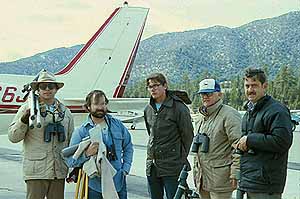 I
also put together two "airplane Big Days" for National Audubon as fund-raisers.
In 1983, our team included Roger Tory Peterson and, therefore, was Big
News... we had three media airplanes following us throughout the day (leading
to articles in Sports Illustrated, Discover magazine, and
the L.A. Times, and a feature on National Public Radio). We tied
the Texas record in 1983, but shattered all records (243 species during
the day) in 1984 with the team shown (left): Jeri M. Langham, me,
John Parmeter, B. D. "Mike" Parmeter, and L. C. Binford. By the end of
the decade, our local Monterey Co. Breeding Bird Atlas project was
underway (published in 1993) and I was a very active atlaser. I
also put together two "airplane Big Days" for National Audubon as fund-raisers.
In 1983, our team included Roger Tory Peterson and, therefore, was Big
News... we had three media airplanes following us throughout the day (leading
to articles in Sports Illustrated, Discover magazine, and
the L.A. Times, and a feature on National Public Radio). We tied
the Texas record in 1983, but shattered all records (243 species during
the day) in 1984 with the team shown (left): Jeri M. Langham, me,
John Parmeter, B. D. "Mike" Parmeter, and L. C. Binford. By the end of
the decade, our local Monterey Co. Breeding Bird Atlas project was
underway (published in 1993) and I was a very active atlaser. |
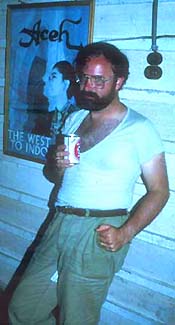 After
a brief job as a tax attorney at Bank of America, I found my career niche
as a research attorney for several local Monterey attorneys. This, and
refinancing the house as rates steadily dropped throughout the decade,
allowed me to travel to Kenya, Papua New Guinea/Australia, Panama, Venezuela,
Peru, and the Greater Sundas (Borneo, Sumatra, Java, Bali). The photo (right)
is from Sumatra. In 1989, I had the unique opportunity to spend four months
at sea on the NOAA research vessel McArthur as a seabird surveyor
on a tuna/porpoise research cruise, searching for seabirds dawn to dusk
daily. The photo below is taken from the McArthur of our sister
ship David Starr Jordan out in the eastern tropical Pacific. The
ship made port calls once a month, permitting short visits to Hawaii, Galapagos,
Ecuador, and Costa Rica. I also married and divorced again during the decade. After
a brief job as a tax attorney at Bank of America, I found my career niche
as a research attorney for several local Monterey attorneys. This, and
refinancing the house as rates steadily dropped throughout the decade,
allowed me to travel to Kenya, Papua New Guinea/Australia, Panama, Venezuela,
Peru, and the Greater Sundas (Borneo, Sumatra, Java, Bali). The photo (right)
is from Sumatra. In 1989, I had the unique opportunity to spend four months
at sea on the NOAA research vessel McArthur as a seabird surveyor
on a tuna/porpoise research cruise, searching for seabirds dawn to dusk
daily. The photo below is taken from the McArthur of our sister
ship David Starr Jordan out in the eastern tropical Pacific. The
ship made port calls once a month, permitting short visits to Hawaii, Galapagos,
Ecuador, and Costa Rica. I also married and divorced again during the decade.
|
|
1990s
| Alas, this decade — a mid-life period — was spent too much at work.
By now I had a full-time job as a research lawyer on retainer to several
firms. But life was pretty good. I had my house and, with the publication
of the Atlas of the Breeding Birds of Monterey County in 1993, my
books (below left). Good intentions to revise and republish Monterey
Birds were slowed when I became "landbirds editor" for the northern
California region in Field Notes (formerly American Birds),
with quarterly deadline commitments, but I did manage to have major identification
papers appear, all based in part on the eastern tropical Pacific research
cruise: on Cookilaria petrels, on small black-and-white shearwaters,
and on Masked/Nazca boobies (details on Publications
page). Yet something very important was missing, and that was remedied
when I met Rita Carratello in 1991 (the photo, below right, is from
Yosemite in 1993). We would get married ten years later, but basically
life has been great since 1991. I've never wanted children — just a good
relationship, our house and its library, and enough time and money to travel
and write.
|
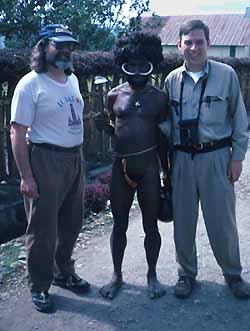 World
travel continued to intrigue me, with visits to such remote destinations
as Irian Jaya, New Guinea. The photo (left) shows three
bachelors in Wamena, Baliem Valley, Irian Jaya, out on the town:
me, a local, and Steve Bailey. I also enjoyed the Philippines, Ecuador,
Madagascar (along with the Seychelles, Mauritius & Réunion;
photo right shows Rita with Ring-tailed
Lemurs at Berenty, Madagascar), Australia again, New Zealand, New
Caledonia, Gabon, Sao Tomé e Príncipe, South Africa, and
Brazil. World
travel continued to intrigue me, with visits to such remote destinations
as Irian Jaya, New Guinea. The photo (left) shows three
bachelors in Wamena, Baliem Valley, Irian Jaya, out on the town:
me, a local, and Steve Bailey. I also enjoyed the Philippines, Ecuador,
Madagascar (along with the Seychelles, Mauritius & Réunion;
photo right shows Rita with Ring-tailed
Lemurs at Berenty, Madagascar), Australia again, New Zealand, New
Caledonia, Gabon, Sao Tomé e Príncipe, South Africa, and
Brazil. |
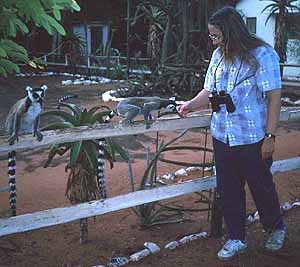
|
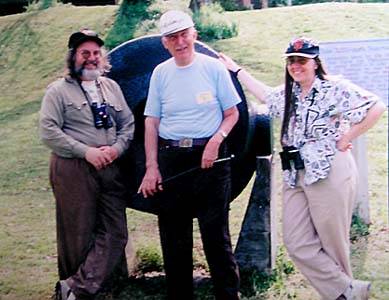 We've
also traveled quite a bit throughout California, trying to learn something
about all 58 counties in the state. In 1996 I participated in another competitive
Big Year — this time limited to Monterey County — and recorded 352 species
which, at the time, were the most birds for any single county anywhere,
anytime. We remodeled the house and started collecting "field guide" art
(Dale Zimmerman, Doug Pratt, R.T. Peterson). We also continued to travel
in North America, looking for birds and exploring historic places, especially
Civil War battlefields (photo right: with famed historian Edwin
C. Bearss at Grand Gulf battlefield in Mississippi, in March 1997). We've
also traveled quite a bit throughout California, trying to learn something
about all 58 counties in the state. In 1996 I participated in another competitive
Big Year — this time limited to Monterey County — and recorded 352 species
which, at the time, were the most birds for any single county anywhere,
anytime. We remodeled the house and started collecting "field guide" art
(Dale Zimmerman, Doug Pratt, R.T. Peterson). We also continued to travel
in North America, looking for birds and exploring historic places, especially
Civil War battlefields (photo right: with famed historian Edwin
C. Bearss at Grand Gulf battlefield in Mississippi, in March 1997). |
|
2000s
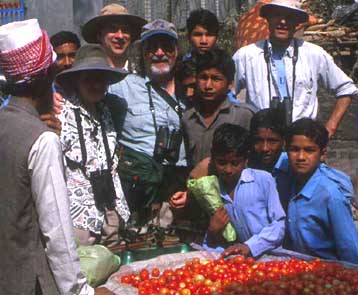 More
foreign travel highlights the first decade of the new century. Here (right)
are Rita and I in India in 2001; our birding friends Steve Bailey and Dan
Singer are the white guys in the back row. More and more often, Rita and
I preferred to organize our own trip with local guides and drivers then
to join tours. India was great on an itinerary we created to meet our priorities.
Also fabulous were trips to Uganda and Borneo (just Rita and me) and to
Tanzania (with two friends). Many of our trips have on-line trip reports
[see trip chronology].
Sometimes, though, when Rita was doing theatre or had work commitments
(she is a teacher), I joined tours: e.g., to Lesser Antilles (2000) or
northern China (2004). By the middle of the decade I reached the 5000 species
mark on my world list — considered to be half of the birds of the world
— and was very near to having seen all the bird families of the world. More
foreign travel highlights the first decade of the new century. Here (right)
are Rita and I in India in 2001; our birding friends Steve Bailey and Dan
Singer are the white guys in the back row. More and more often, Rita and
I preferred to organize our own trip with local guides and drivers then
to join tours. India was great on an itinerary we created to meet our priorities.
Also fabulous were trips to Uganda and Borneo (just Rita and me) and to
Tanzania (with two friends). Many of our trips have on-line trip reports
[see trip chronology].
Sometimes, though, when Rita was doing theatre or had work commitments
(she is a teacher), I joined tours: e.g., to Lesser Antilles (2000) or
northern China (2004). By the middle of the decade I reached the 5000 species
mark on my world list — considered to be half of the birds of the world
— and was very near to having seen all the bird families of the world. |
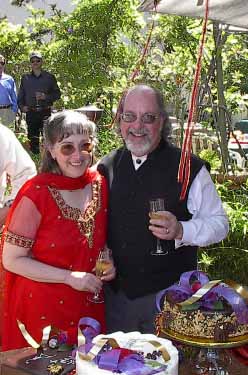 On
4 May 2002, Rita and I got married, just a couple days before my 50th birthday.
It was a fun outdoor wedding at our favorite local birding spot — next
to the Carmel River — followed by an outdoor reception at an Indian restaurant
[more photos here].
We love our Pacific Grove home and yard, and Rita adopted an SPCA declawed
cat who lives in the house and only looks at the birds in the backyard
(below). He is named General Grant.
These pages are mostly about change over time and I find something to think
about in the photo (above) of General Grant looking out the window.
See the trunk of the pine tree just off the deck and the hot tub? About
1990, it was clear that this dead tree was a clear and present danger of
falling in a big windstorm and hitting the house, so we had it topped,
leaving a 30 foot stub. In spring 2002, a pair of Nuttall's Woodpeckers
nested in that stump (male shown above right), the first confirmed
nest in Pacific Grove. A couple years later, Hairy Woodpeckers nested there.
But the day before New Year's in Dec 2004, even this stump fell in a big
storm, hitting the deck but stopping short of the house. Now the General's
view of this part of the yard is much more open . . . Here's
a view (below) of our house from the back yard. On
4 May 2002, Rita and I got married, just a couple days before my 50th birthday.
It was a fun outdoor wedding at our favorite local birding spot — next
to the Carmel River — followed by an outdoor reception at an Indian restaurant
[more photos here].
We love our Pacific Grove home and yard, and Rita adopted an SPCA declawed
cat who lives in the house and only looks at the birds in the backyard
(below). He is named General Grant.
These pages are mostly about change over time and I find something to think
about in the photo (above) of General Grant looking out the window.
See the trunk of the pine tree just off the deck and the hot tub? About
1990, it was clear that this dead tree was a clear and present danger of
falling in a big windstorm and hitting the house, so we had it topped,
leaving a 30 foot stub. In spring 2002, a pair of Nuttall's Woodpeckers
nested in that stump (male shown above right), the first confirmed
nest in Pacific Grove. A couple years later, Hairy Woodpeckers nested there.
But the day before New Year's in Dec 2004, even this stump fell in a big
storm, hitting the deck but stopping short of the house. Now the General's
view of this part of the yard is much more open . . . Here's
a view (below) of our house from the back yard. |
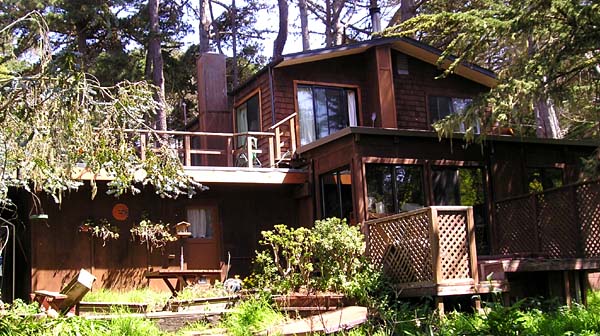
|
| This page is updated in early 2005, so here (right) are recent
photos of me and of Rita (and her artist friend Greg Harris), both taken
in New Mexico on a day with gorgeous skies. We hope for continuing good
times in the future . . . |
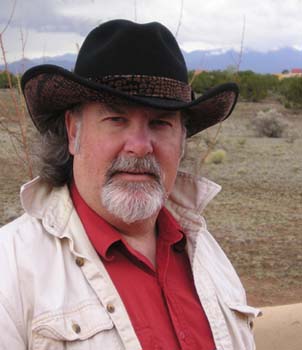
|
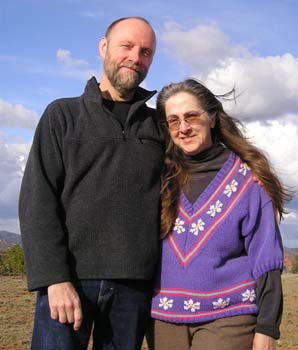
|
|
|